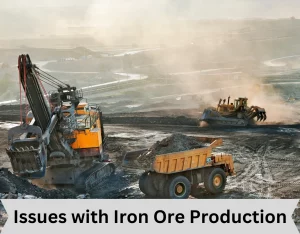ForumIAS announcing GS Foundation Program for UPSC CSE 2025-26 from 27th May. Click Here for more information.
Source: This post on Issues with Iron Ore Production has been created based on the article “Iron ore faces challenges of sustainability and fairness” published in “Live Mint” on 5th February 2024.
UPSC Syllabus Topic: GS Paper 3 – Indian Economy – Changes in industrial policy.
News: Issues with Iron Ore Production, The article discusses the issues with iron ore production in Odisha and the recommendations to tackle them.
Background:
The Competition Commission of India (CCI) recently published a report with a view to identify and addressing anticompetitive practices in the country’s iron ore sector.
According to the author, it will act as a guide to the government’s recent announcement of a plan to auction around 500 mineral blocks by fiscal year 2025-26
What are The Findings of The Report Regarding Iron Ore Production in Odisha?
The production of iron ore is concentrated in a few states, such as Odisha (around 54% of the total). Odisha is seen to have a competitive advantage in iron ore mining due to good infrastructure and efficient administrative set-up.
The report highlights that high prices of iron ore in Odisha are affecting the viability of small-scale pellet and sponge iron manufacturers.
Note:
Sponge iron is produced from the direct reduction of iron ore (in the form of lumps, pellets, or fines) into iron by a reducing gas which either contains elemental carbon (produced from natural gas or coal) or hydrogen.
Iron ore pellets are small, hard, spherical particles made from fine iron ore concentrate. They are used in the blast furnace process to produce hot metal.
What is The Issue with Iron Ore Production in Odisha?
1) Excessive Base Prices: Base prices for auctions are excessive and have no relation to market realities such as the cost of production.
In some cases, iron ore prices were close to the market price of pellets. This led to the shutdown of some pellet manufacturers.
2) Lack of Competition: The practice of private mines using these base prices as a reference price also takes away the possibility of any price-based competition between private mines and government mining company.
3) Issues with Long-Term Arrangements: Although LTAs ensure supply consistency, the report has highlighted that due to minimum purchase obligations under LTAs, industries have to also buy low-quality iron ore, as there is no quality-control mechanism in place.
What does The Report Recommend in This Regard?
1. Transparent Pricing: The base price for auctions should be calculated through a transparent methodology. This can be done by linking the base price to a price index that should be publicly available.
2. Auction to prevent Overpricing: To ensure that iron ore is not overpriced, all quantities produced in the state (by PSUs or private mines) could be sold through an auction.
3. Regarding LTAs: Pricing under LTAs also can be linked to a price index, instead of being based on auction prices. Also, the minimum purchase requirements under LTAs should be subject to the required quality or grade of iron ore.
4. Expanding Access to Iron Ore: Iron ore production in India is limited to only a few states, and access to it is restricted to industrial customers based in only these states. The report has suggested that it should be made available to industries outside Odisha through LTAs.
The iron ore market study recommendations should be followed to foster competitive neutrality between public and private players, ensuring a level playing field. It will ensure right allocation of non-renewable resources.
Question for practice:
What are the issues with iron ore production in Odisha? Suggest steps to tackle them.





